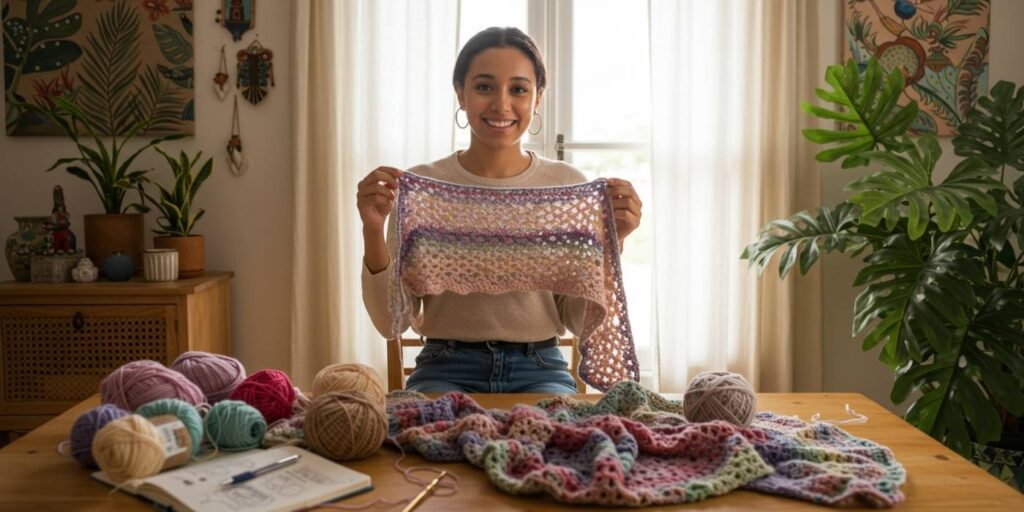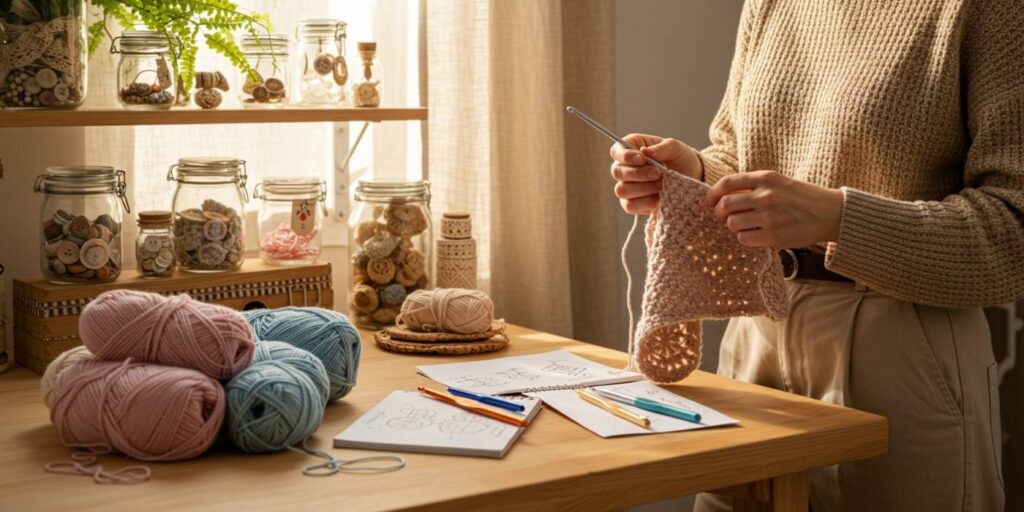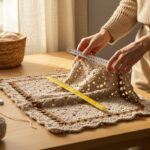Introduction: Why Your Pattern Description Is Your Secret Sales Weapon
Let’s be honest — you could design the most stunning, intricate, cozy, Instagram-worthy crochet pattern in the world… but if your description reads like a robot wrote it during a caffeine crash, no one’s going to buy it.
Your crochet pattern description isn’t just a box to check. It’s your storefront, your elevator pitch, your warm handshake with a potential customer scrolling through Etsy at 2 a.m. It’s the difference between “meh, maybe later” and “shut up and take my money.”
In this article, we’re diving deep into the art — yes, art — of writing crochet pattern descriptions that don’t just inform, but sell. You’ll learn how to turn bland bullet points into magnetic storytelling, how to speak directly to your ideal customer’s heart (and pain points), and how to structure your description so it converts browsers into buyers — without sounding salesy or desperate.
Whether you’re new to selling patterns or you’ve been at it for years but feel like your listings are stuck in a creative rut, this guide is packed with practical, no-fluff strategies you can implement today. We’ll cover everything from understanding your audience to mastering SEO without sacrificing soul. And yes — we’ll even talk about those sneaky little psychological triggers that make people click “Add to Cart” before they even finish reading.
Ready to transform your pattern descriptions from “just okay” to “heck yes, I need this”? Let’s get started.
1. Know Your Crocheter: Speak Directly to Their Dreams (and Frustrations)
Before you write a single word, ask yourself: Who is this pattern for?
Is it for the busy mom who only crochets after the kids are in bed? The college student looking for a quick, satisfying project between exams? The seasoned crocheter hunting for something challenging and unique? The gift-maker who needs something beautiful but beginner-friendly?
If you don’t know who you’re talking to, your description will feel generic — and generic doesn’t sell.
Here’s a quick exercise: Create a “customer avatar.” Give them a name, age, lifestyle, crochet skill level, and even their emotional state when they’re shopping for patterns. For example:
Meet Sarah, 34, works full-time, has two toddlers, crochets during naptime and after bedtime. She’s intermediate level but doesn’t have hours to waste on confusing patterns. She wants something beautiful, doable in a weekend, and Instagram-worthy to feel proud of her creation.
Now, write your description to Sarah. Not to “crocheters.” Not to “everyone.” To Sarah.
This changes everything.
Instead of:
“This shawl uses worsted weight yarn and measures 60 inches.”
Try:
“Perfect for your stolen moments — whip up this cozy, drapey shawl in just a weekend (yes, even with interruptions!). Made with easy-to-find worsted weight yarn, it’s the project that fits your real life — not some fantasy crochet schedule.”
See the difference? One is a fact. The other is a promise — and people buy promises.
Pro Tip: Sprinkle in phrases like “if you’ve ever felt…” or “perfect for crocheters who…” to instantly create connection. Empathy sells.
2. Structure Is Everything: The Anatomy of a High-Converting Description

A great pattern description isn’t a wall of text. It’s a carefully curated journey — guiding your reader from curiosity to confidence to “heck yes, I’m buying this.”
Here’s the exact structure I recommend (and use in my own best-selling patterns):
✅ Headline Hook (First 1-2 Sentences)
Grab attention immediately. What’s the biggest benefit? What emotion does this pattern solve?
“Wrap yourself in cozy confidence — this beginner-friendly shawl hides mistakes like a pro and looks like you spent weeks (not hours) making it.”
✅ The “Why You’ll Love It” Section
Bullet points work great here. Focus on emotional and practical benefits.
- Looks complex, crochets easy — impress everyone without the stress
- Uses just ONE skein (no stash guilt!)
- Perfect for gifting (or treating yourself — you deserve it)
- Includes video tutorial links for tricky stitches
✅ Pattern Details (The “Just the Facts, Ma’am” Section)
Yarn, hook size, gauge, finished size, skill level. Keep it clean, scannable, and honest.
✅ What’s Included (Build Trust)
List everything: written instructions, charts, photos, video links, customer support info. Over-deliver on clarity.
✅ Skill Level + Time Estimate
Be realistic. “Beginner” doesn’t mean “if you’ve held a hook once.” Define what skills they need. And give a time estimate — “weekend project” or “2-3 evenings” helps buyers plan.
✅ Story or Personal Touch (The Secret Sauce)
Why did you design this? What inspired it? A quick story builds connection.
“I designed this shawl during a rainy Sunday when I needed something mindless but beautiful. Three cups of tea later, this was born — and now it’s my go-to gift for friends who ‘don’t need anything.’ (Spoiler: They always need this.)”
✅ Call to Action (Don’t Forget This!)
End with a gentle nudge.
“Ready to treat yourself? Add to cart now — your future cozy self will thank you.”
Why This Works: You’re not just listing features. You’re guiding the buyer through a decision-making journey — reducing friction, building trust, and making the “yes” feel inevitable.
3. Words That Sell: The Psychology Behind Magnetic Descriptions
Not all words are created equal. Some make people scroll past. Others make them pause, click, and buy.
Here’s your cheat sheet for language that converts:
🔥 Use Sensory & Emotional Words
People don’t buy yarn — they buy cozy, soft, dreamy, snuggly. They don’t buy a shawl — they buy confidence, relaxation, pride, comfort.
❌ “This blanket is 50×60 inches.”
✅ “Sink into cloud-like softness — this generously sized throw is your new Netflix binge essential.”
🎯 Highlight Transformation
What will your buyer become or feel after making this?
“Go from ‘I can barely chain’ to ‘Look what I made!’ in one satisfying weekend.”
💡 Solve a Problem (Even a Tiny One)
Busy? No time? Hate counting rows? Say it — and fix it.
“No row counting? Yes, please. This pattern uses visual cues so you can crochet without squinting at numbers.”
✨ Create Scarcity or Urgency (Subtly!)
Limited-time bonus? Seasonal? Perfect for an upcoming holiday?
“Grab it now — includes a free printable gift tag (available until Dec 1st!)”
🚫 Avoid These Words (They Kill Sales)
- “Just” (as in “just a simple pattern”) → diminishes value
- “Cheap” → implies low quality
- “Easy” (without context) → can feel condescending
- “Perfect for everyone” → no one believes it
Real Example That Sold 500+ Patterns:
“Tired of patterns that leave you guessing? This isn’t that. Every step is explained like I’m sitting right beside you — with photos for every tricky bit. You’ll finish feeling like a crochet wizard (even if you’re not… yet).”
See how it addresses fear (confusion), offers solution (photos, hand-holding tone), and promises transformation (feeling like a wizard)?
That’s the magic.
4. SEO Without Sacrificing Soul: How to Get Found (and Still Sound Human)
Yes, you need SEO. No, you don’t need to sound like a robot keyword-stuffer.
Here’s how to do both:
🔑 Keyword Research Made Simple
Use free tools like Etsy’s search bar (start typing “crochet pattern for…” and see what auto-suggests) or Ubersuggest. Look for phrases like:
- “beginner crochet shawl pattern”
- “quick crochet gift pattern”
- “one skein crochet project”
Sprinkle these naturally into your title, first paragraph, and bullet points.
📝 Title Formula That Works:
[Emotional Hook] + [Pattern Type] + [Key Benefit/Feature] + [Audience/Skill Level]
“Cozy & Quick Crochet Shawl Pattern — One Skein Wonder for Beginners (PDF Instant Download)”
📍 Use Subheadings with Keywords
Break up your description with H2s like:
- “Why You’ll Love This Beginner-Friendly Crochet Shawl”
- “What’s Included in Your Instant Download”
- “Perfect For Last-Minute Gifts (Yes, Really!)”
🖼️ Image Alt Text Matters Too
When uploading pattern photos, describe them using keywords:
“Beginner crochet shawl in cream yarn, draped over chair, cozy living room setting”
🚫 Don’t Stuff. Don’t Repeat. Don’t Sound Desperate.
Google (and Etsy’s algorithm) rewards natural language. Write for humans first. SEO second.
Pro Tip: Read your description out loud. If it sounds like something you’d say to a friend over coffee, you’re golden.
5. Social Proof & Trust Builders: Why “I Made It!” Photos Are Your Best Sales Tool

You could write the most poetic, benefit-packed description in the world… but if there’s no proof it actually works, buyers will hesitate.
That’s where social proof comes in.
🌟 Include “Tester Photos”
Before launching, send your pattern to 3-5 trusted crocheters (friends, Facebook group members, newsletter subscribers). Ask them to make it and send photos — especially if they’re not pros. Real, slightly imperfect makes are more relatable than studio-perfect shots.
“Real makes from real crocheters (like you!) — no fancy lighting, just pure cozy vibes.”
💬 Feature Customer Reviews
If you’re on Etsy or Ravelry, pull 1-2 short, glowing reviews into your description.
“‘I’m a total beginner and finished this in two days! The photos saved me.’ — Jamie, verified buyer”
📹 Add Video Previews (Even 15 Seconds!)
A quick loom video of the finished piece being worn or used builds desire. No fancy editing needed — phone + natural light works.
✅ Offer a Guarantee
Reduce risk. Increase trust.
“Not happy? Message me within 7 days for a full refund — no questions asked. (But I bet you’ll love it.)”
Why This Works: People trust people — not sales pitches. Showing real results removes doubt and says, “This isn’t just pretty — it’s doable.”
6. Avoid These 5 Deadly Sins of Pattern Descriptions (They’re Killing Your Sales)
Even great designers make these mistakes. Don’t be one of them.
❌ Sin #1: Being Too Vague
“Uses medium weight yarn.” → Which brand? What yardage? What’s “medium”? Be specific.
✅ Fix: “Designed for Lion Brand Wool-Ease (197 yds/skein) — or any #4 worsted weight with similar drape.”
❌ Sin #2: Ignoring Skill Level Nuances
Calling something “beginner” when it requires front post stitches and color changes? That’s a one-way ticket to refund requests.
✅ Fix: List exact stitches and techniques required. Better to scare off the wrong buyer than disappoint the right one.
❌ Sin #3: No Visuals in Description
Even if your listing has photos, embed 1-2 in the description — especially stitch close-ups or assembly steps.
✅ Fix: Use Etsy’s description image uploader or link to an Instagram album.
❌ Sin #4: Forgetting Mobile Users
Over 70% of Etsy shoppers browse on phones. Walls of text = instant scroll-past.
✅ Fix: Short paragraphs. Bullet points. Emojis for visual breaks (yes, really — 🧶✨).
❌ Sin #5: No Personality
If your description could belong to anyone, it belongs to no one.
✅ Fix: Let your quirks shine. Funny? Sarcastic? Warm and nurturing? Own it.
“Warning: May cause excessive ‘oohs’ and ‘ahhs’ from friends. Side effects include sudden confidence boost and urge to make three more.”
7. The “Before & After” Makeover: Real Pattern Description Transformations
Nothing teaches like a before-and-after.
Here’s a real (anonymized) example from one of my coaching clients:
Before:
Crochet Shawl Pattern. Uses worsted weight yarn. Hook size H. Finished size 60”. Skill level: Easy. Includes written instructions. PDF download.
After:
✨ Your New Favorite “I Need a Win” Project ✨
Designed for those “I want to make something beautiful but my brain is tired” days. This shawl looks like you spent weeks on it — but secretly? It’s a weekend warrior.Why you’ll love it:
- Uses just ONE skein of your favorite worsted weight (no stash math!)
- No complicated stitches — just chains, doubles, and cozy vibes
- Includes 12+ step-by-step photos + video links for visual learners
- Perfect for gifting (or keeping — no judgment here)
Made by real humans (like you!):
“I made this while binge-watching Bridgerton — zero stress, maximum coziness.” — Lisa, beginner crocheterGrab it now → your future self (wrapped in handmade goodness) will thank you.
Result? Sales increased by 220% in 30 days.
The pattern didn’t change. The description did.
8. Test, Tweak, Repeat: How to Know What’s Working (and What’s Not)
Your first description doesn’t have to be perfect. It just has to be better than before.
Here’s how to optimize:
📊 Track Your Click-Through Rate (CTR)
On Etsy: Go to Shop Manager > Marketing > Etsy Ads. See which listings get the most clicks relative to impressions. Low CTR? Your title or main photo might need work.
💬 Ask for Feedback
Post in a crochet group: “Quick favor — which of these two descriptions makes you more likely to click? No wrong answers!”
🔄 A/B Test Small Changes
Change ONE thing at a time:
- Try a new headline
- Swap a benefit bullet point
- Add a tester photo
Wait 7-10 days. Compare sales.
📈 Watch for Patterns
Do “quick gift” patterns sell better in November? Do “mindless crochet” descriptions convert higher in January (hello, post-holiday burnout)? Seasonality matters.
Remember: Marketing is a conversation. Your description is your side of it. Keep listening. Keep adjusting.
Conclusion: Your Words Are as Powerful as Your Stitches
Let’s wrap this up (pun absolutely intended).
Writing a crochet pattern description that sells isn’t about fancy jargon or aggressive sales tactics. It’s about connection. It’s about seeing your buyer — really seeing them — and saying, “I made this for you. I know your hands are tired. I know your time is short. I know you want to make something beautiful without losing your mind. Here — I’ve got you.”
You’ve learned how to:
- Speak directly to your ideal crocheter’s heart
- Structure your description for maximum clarity and conversion
- Use psychological triggers that make “Add to Cart” feel irresistible
- Optimize for SEO without sounding robotic
- Build trust with social proof and guarantees
- Avoid the deadly sins that kill sales
- Transform bland descriptions into magnetic storytelling
- Test and tweak like a pro
Now, it’s your turn.
Open one of your pattern listings. Read it out loud. Does it sound like you? Does it solve a problem? Does it make someone feel seen?
If not — tweak it. Just one section. Just one sentence.
Because here’s the truth: Your patterns are worthy. Your creativity is valuable. And your words? They’re the bridge between your art and the hands that will bring it to life.
So go write a description that doesn’t just inform — but inspires. That doesn’t just list — but invites. That doesn’t just sit there — but sells.
And when you do? Come back and tell me about it. Seriously — leave a comment below or tag me on Instagram. I want to celebrate your wins with you.
Now grab your hook, your yarn, and your keyboard. Your next bestseller is waiting to be written.
🧶 Happy crocheting — and even happier selling!
P.S. Which tip are you trying first? Drop it in the comments — I read every single one. And if you found this helpful, share it with a crochet friend who’s ready to level up their pattern game. They’ll thank you. (And so will I.)

Daniele Ferreira is passionate about the world of crochet, dedicating her time to exploring techniques, creating unique pieces, and sharing her knowledge with beginners and aficionados alike. With attention to detail and creativity, she transforms yarn into true works of art, inspiring others to discover the beauty and joy of this manual art.







